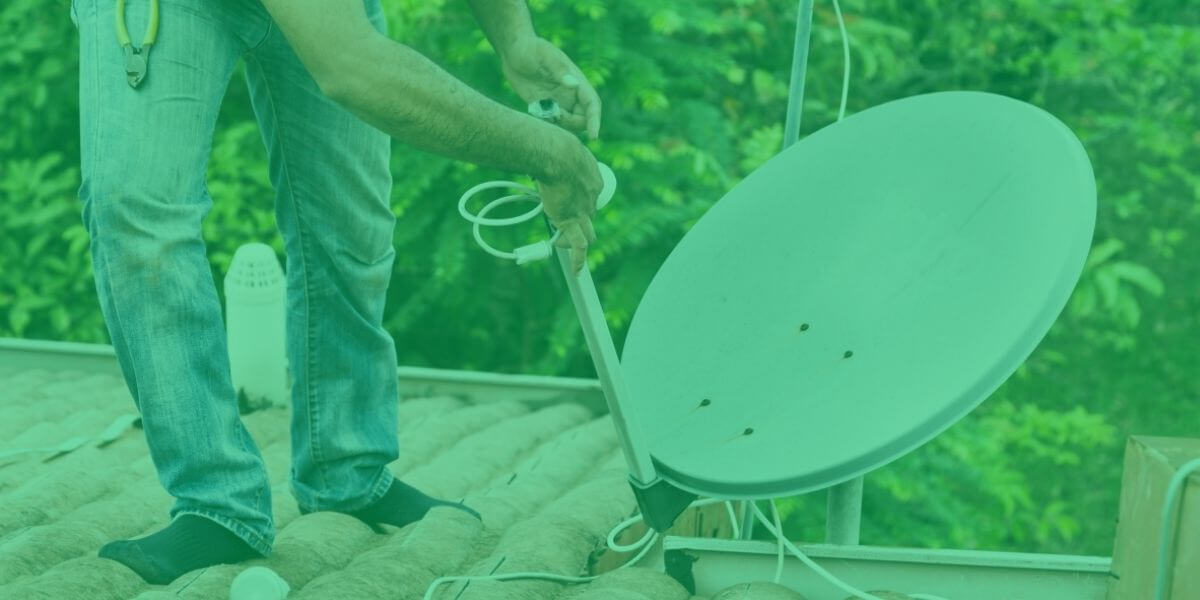Lower your internet bill
61% of people overpay for their internet.
Are you one of them?
Unlock exclusive offers in your area!
Call now
[tel]Enter zip code
1 Star is Poor & 5 Stars is Excellent.
* Required

Written by Rosslyn Elliott - Pub. Nov 17, 2023 / Updated Mar 18, 2024
Table of Contents
Are you happy with your Internet service?

About the author
Have you ever wondered if satellite internet is a strong option for your home or business? Satellite can cover almost all homes in the U.S., as well as many around the world. If you live in a rural area, satellite may be one of your only choices for internet service.
But how exactly does it work, and will a satellite internet connection be reliable and fast? This article will give you all the basics on satellite internet, so you can decide: is satellite internet good for my needs?
Satellite internet works by using satellites in space to transmit a wireless internet signal.
A satellite dish installed at your home points toward the sky to send signals to a service provider’s satellite. The satellite relays the signal to a ground station, which connects to the wider internet network. When the ground station receives data from the internet, the station “bounces” that data back up into space to the satellite. Finally, the satellite beams the signal back to your home’s satellite dish.
What an impressive journey! Because many satellites are 22,000 miles above earth, every internet signal and response travels 88,000 miles to reach you. And it all happens in a split second.
Because satellite internet doesn’t need wiring, it can reach places that cable and DSL can’t.
The basics of satellite internet have been around since the 1990s. Over the years, new technologies have greatly improved satellite broadband capabilities. Today’s satellite internet provides speeds faster than some DSL plans.

A signal travels 88,000 miles
One of the biggest perks of satellite internet is availability almost anywhere. As long as you have a clear view of the southern sky, you can get a satellite connection. This makes it a great option for rural areas without access to wired broadband. Even in cities, satellite can sometimes compete with DSL.
Another major benefit is that satellite internet requires no ground infrastructure. The wireless signal comes straight through the air. This means satellite can provide internet access to remote locations without needing miles of cable.
Satellite internet speeds and bandwidth have also improved considerably in recent years. New satellites have launched that provide higher capacity. Service providers now offer plans with 25 Mbps download speeds or more. While satellite still can’t match fiber optics for speed, it’s definitely faster than a slow DSL plan.
The most common complaint about satellite internet is lag caused by signal distance. This latency means more delay with back-and-forth communications like video chatting. Online gamers may also struggle with lag using satellite internet.
Satellite signals get disrupted in heavy rain and storms. Though providers say outages are rare, inclement weather can slow speeds. Connections may lag or drop temporarily if there’s an extreme weather event.
Data caps are another downside of satellite. Most providers have monthly data limits from 15GB to 500 GB or more. Additional data charges can add up fast. Some providers have “soft data caps” that will not bring you automatic overage charges, but will slow down your connection if you go over your data limit.
If you’re thinking about playing a lot of real-time multiplayer games online, satellite internet will not be your best best—at least, not for a few more years. Until technology advances a little farther, most satellite connections just can’t promise the kind of split-second reaction you need for real-time gaming.

Rain fade
How does satellite stack up to alternatives like DSL, cable internet, fiber internet, and mobile internet?
First, satellite internet works just like other internet and can run to a router in your home that supports your home Wi-Fi network.
Satellite generally has slower speeds than fiber, but faster than DSL. Newer DOCSIS 3.1 cable connections outpace satellite, while fiber leaves satellite in the dust. In other words, satellite is not the fastest internet in the country. But it may be the fastest in your area.
Satellite latency is higher than other broadband types. DSL, cable, and fiber have more responsive connections with lower lag.
Most satellite plans have data caps, while cable and fiber usually offer unlimited data. Satellite competes better with capped mobile data plans.
Severe weather impacts satellite more than other broadband types, while terrestrial options are less prone to disruption.
For remote users beyond the reach of wired infrastructure, satellite is widely available while alternatives are scarce. Satellite internet can provide fast, reliable service to those in rural areas. For urban users with access to cable or fiber, satellite is less appealing.
The initial equipment cost for satellite ranges from $200 to $800 for purchase and professional setup. Leased equipment can lower the upfront cost but adds monthly fees. Free installation comes with most satellite plans.
Satellite internet service starts around $50 per month and goes up depending on data caps. Speed tiers and bundled extras can increase the monthly price.
Most providers require a one or two-year contract. You may pay early termination fees if you cancel service before the contract term ends. Setup and equipment fees may apply if you move locations.

Individual experiences with satellite internet vary considerably based on factors like location, weather, equipment, and usage habits. Customer satisfaction ratings range widely among providers.
For rural users without other options, satellite earns high marks for availability. But data caps, weather sensitivity, and lag frustrate some customers. Refund policies for service outages appease some disgruntled users.
Businesses like farms, hotels, and gas stations use satellite when cable and phone lines are unavailable. Performance for simple functions like point-of-sale and email is acceptable, but satellite lags for bandwidth-heavy tasks.
Recent years have brought major satellite broadband advancements:
More launches of HTS and LEO satellites promise continued improvement in speed, reliability, and performance. Ongoing innovations are helping satellite internet keep pace as an alternative broadband solution.
Not all satellite broadband providers are equal. Comparing plans, fees, equipment, technologies, and customer service will help you identify the best fit.
Look for suitable data caps and speeds for your needs. Confirm service availability for your location before signing up. Read customer reviews to gauge reliability and support satisfaction.
Understand the terms of service contracts and early termination fees. Ask about weather outage policies and speed optimization. Choose a provider that offers robust customer support for setup and maintenance.

Free installation
Installing satellite internet involves carefully positioning the satellite dish with line-of-sight to the provider’s satellite.
Professional installation is the easiest option and is often required by providers. Trained technicians have the equipment and expertise to handle the antenna placement and wiring. DIY installs are possible but require effort and accuracy.
Consider DIY satellite installation if you’re able to climb on your roof and maneuver the dish safely. It saves on labor costs but you provide the equipment. DIY only makes sense if you have a clear view of the southern sky from a suitable roof location.
Leave it to the pros if your home lacks safe roof access or the needed tools and equipment. Tricky mounting locations like steep roofs are best handled by technicians with lift equipment. Professional installation is free from most satellite ISPs.
Satellite internet works great if you pay attention to your data management and follow a few general principles.
With good bandwidth management and equipment care, you can enjoy smooth satellite internet performance.

Satellite connects the world
New satellites coming online over the next few years promise exciting improvements:
With these coming innovations, the future looks bright for satellite to provide widespread broadband connectivity around the world. Satellite internet is sure to continue evolving as a high-performance option even in areas with other alternatives.
Satellite internet offers broadband access virtually anywhere with clear views to the southern sky. It provides high speeds, though often with data caps and lag.
While satellite can’t match the performance of fiber or HFC cable, satellite fills connectivity gaps in rural and remote regions.
For the right user, satellite internet can enable broadband access. And for that reason, we can answer our original question: satellite internet is very good! Without satellite technology, billions of people would be left on the wrong side of the digital divide.
Satellite can now bring you up to FCC broadband speed and faster. You can pursue a wide variety of activities through a satellite internet connection for entertainment, education, or remote work. You can also see a doctor long-distance through telemedicine, which is especially important in remote areas.
Recent technology advances have improved satellite capabilities, with more promising innovations ahead. To see what internet service providers are available in your area, enter your zip code for detailed plan and pricing comparisons.

About the author
Congratulations, you qualify for deals on internet plans.
Speak with our specialists to access all local discounts and limited time offers in your area.
[tel]61% of people overpay for their internet.
Are you one of them?
Unlock exclusive offers in your area!
Call now
[tel]Enter zip code